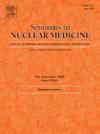FAPI PET Versus FDG PET/CT in Gastrointestinal Cancers: An Overview
IF 5.9
2区 医学
Q1 RADIOLOGY, NUCLEAR MEDICINE & MEDICAL IMAGING
引用次数: 0
Abstract
Fibroblast activation protein (FAP) is a type II transmembrane serine protease that is highly expressed in cancer-associated fibroblasts (CAFs) but absent in quiescent fibroblasts. Its overexpression is associated with poor prognosis in various cancers and contributes to treatment resistance. In recent years, radiolabeled FAP inhibitors (FAPI) for PET imaging have shown promising clinical value across a range of cancers. Gastrointestinal (GI) malignancies, which often exhibit a desmoplastic reaction with a high density of FAP-expressing CAFs, are particularly well-suited for FAPI PET. Given the limitations of [18F]FDG PET in GI cancers, such as low sensitivity in certain histological subtypes and high physiological background uptake, FAPI PET is expected to serve as a complementary method, potentially enhancing both diagnostic accuracy and treatment guidance. This review provides a comprehensive comparison of the clinical applications of FAPI PET and [18F]FDG PET in various GI cancers, including their value in diagnosis, staging, and treatment guidance. Additionally, this review summarizes studies on the expanding role of FAPI PET, including its use in assessing treatment response and predicting prognosis, aiming to provide insights into its potential contribution to the improved management of GI malignancies.
FAPI PET与FDG PET/CT在胃肠道癌症中的对比:综述。
成纤维细胞活化蛋白(FAP)是一种II型跨膜丝氨酸蛋白酶,在癌症相关成纤维细胞(CAFs)中高表达,但在静止成纤维细胞中不表达。它的过表达与各种癌症的不良预后有关,并有助于治疗耐药。近年来,放射性标记FAP抑制剂(FAPI)用于PET成像已显示出在一系列癌症中有希望的临床价值。胃肠道(GI)恶性肿瘤通常表现为高密度表达FAPI的caf的结缔组织增生反应,特别适合FAPI PET。考虑到[18F]FDG PET在胃肠道肿瘤中的局限性,如某些组织学亚型的低敏感性和高生理背景摄取,FAPI PET有望作为一种补充方法,潜在地提高诊断准确性和治疗指导。本文综述了FAPI PET和[18F]FDG PET在各种胃肠道肿瘤中的临床应用,包括其在诊断、分期和治疗指导方面的价值。此外,本综述总结了FAPI PET扩大作用的研究,包括其在评估治疗反应和预测预后方面的应用,旨在深入了解其对改善胃肠道恶性肿瘤管理的潜在贡献。
本文章由计算机程序翻译,如有差异,请以英文原文为准。
求助全文
约1分钟内获得全文
求助全文
来源期刊

Seminars in nuclear medicine
医学-核医学
CiteScore
9.80
自引率
6.10%
发文量
86
审稿时长
14 days
期刊介绍:
Seminars in Nuclear Medicine is the leading review journal in nuclear medicine. Each issue brings you expert reviews and commentary on a single topic as selected by the Editors. The journal contains extensive coverage of the field of nuclear medicine, including PET, SPECT, and other molecular imaging studies, and related imaging studies. Full-color illustrations are used throughout to highlight important findings. Seminars is included in PubMed/Medline, Thomson/ISI, and other major scientific indexes.
 求助内容:
求助内容: 应助结果提醒方式:
应助结果提醒方式:


